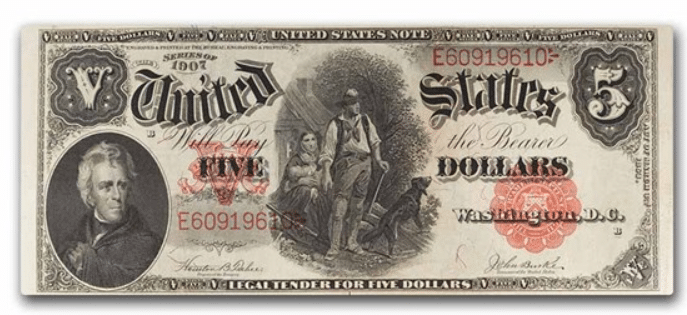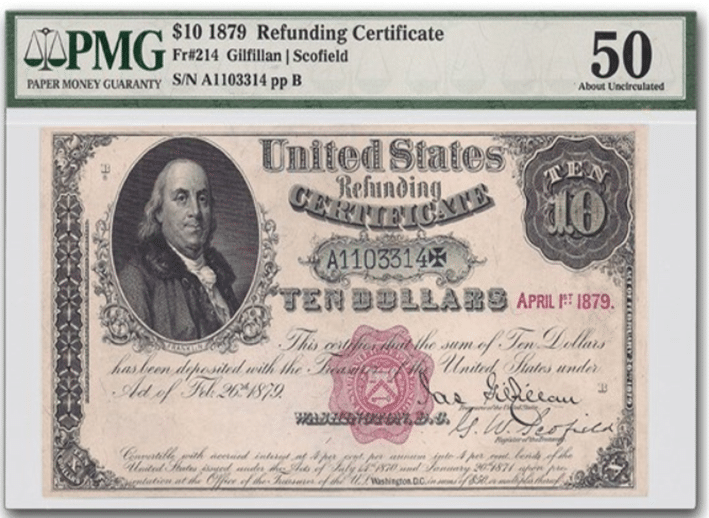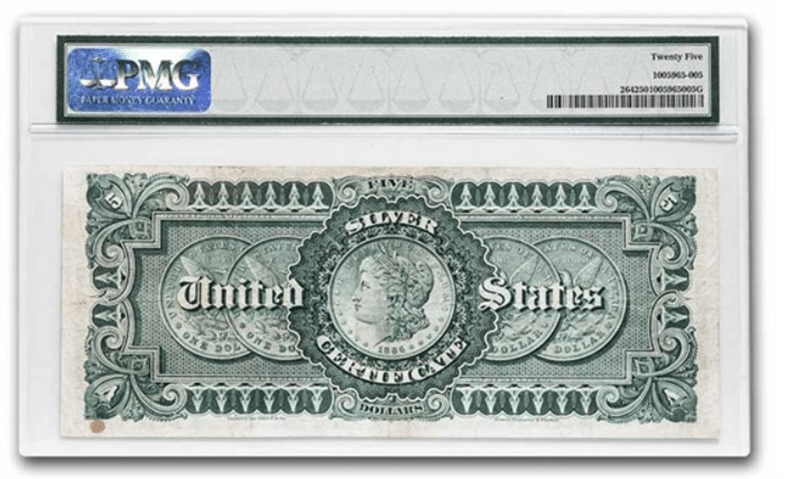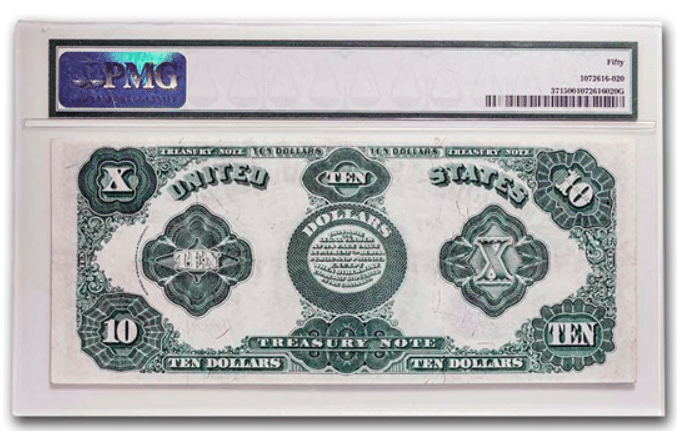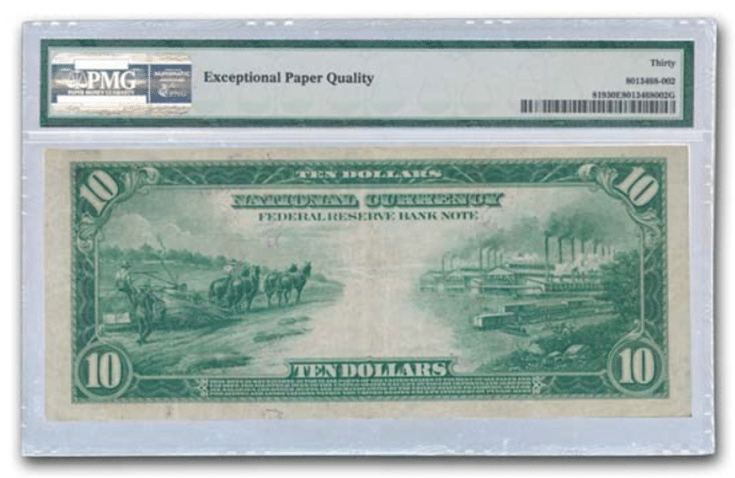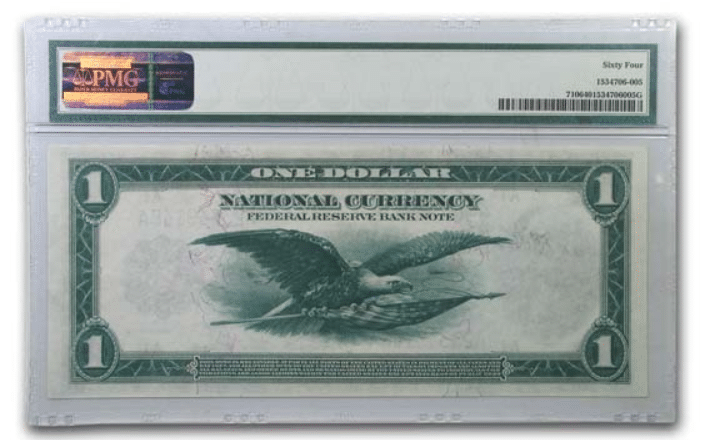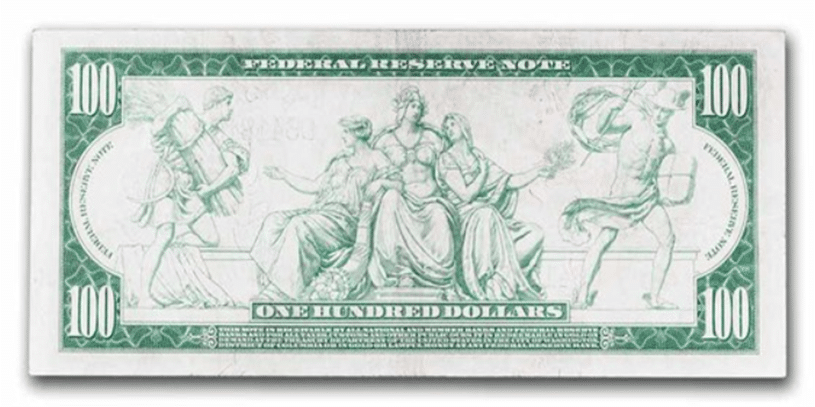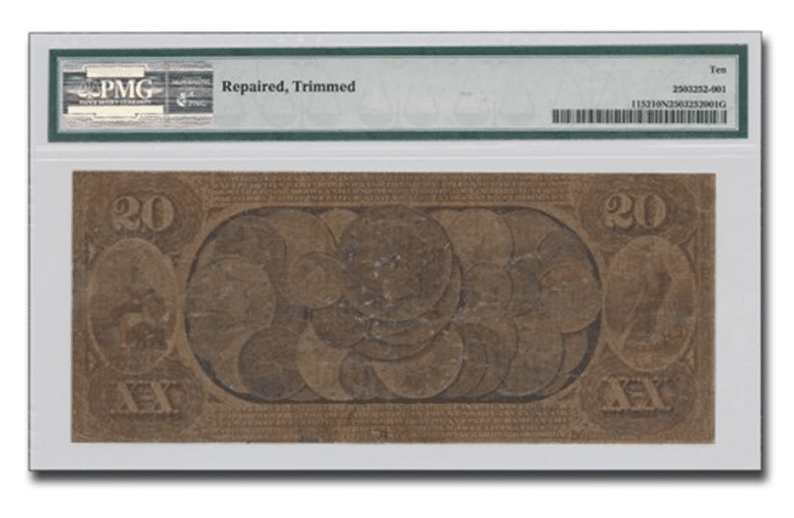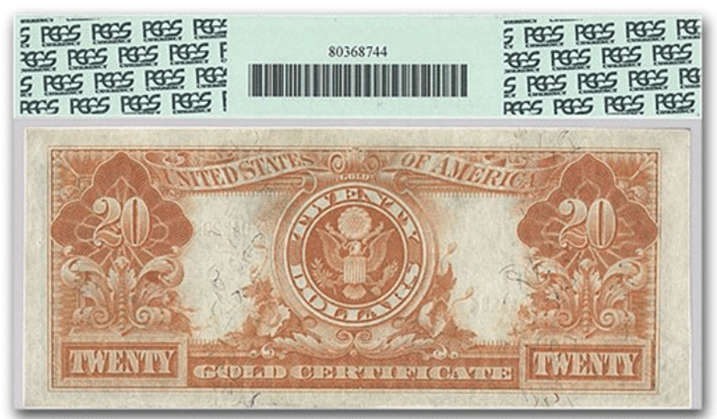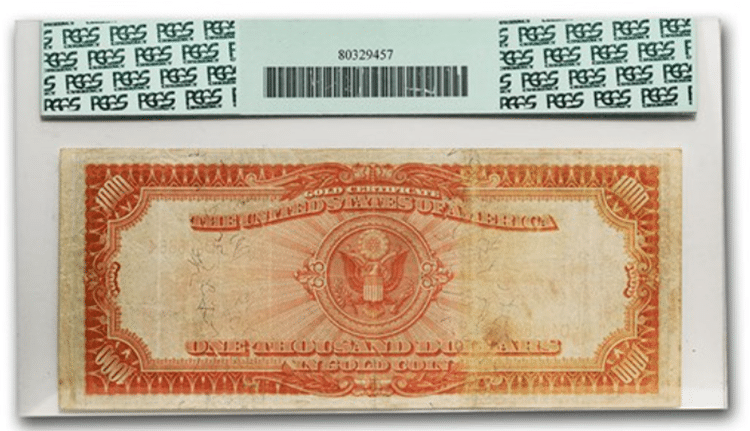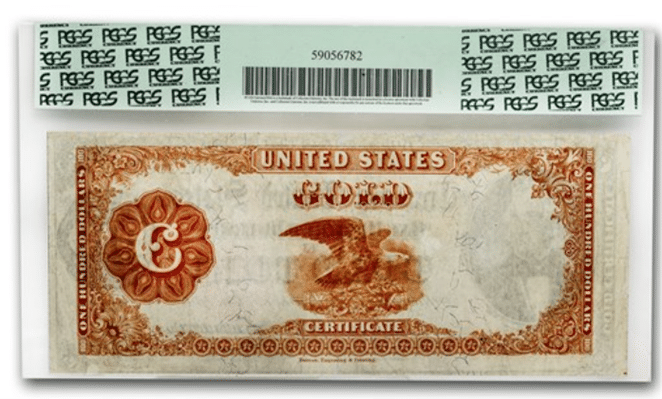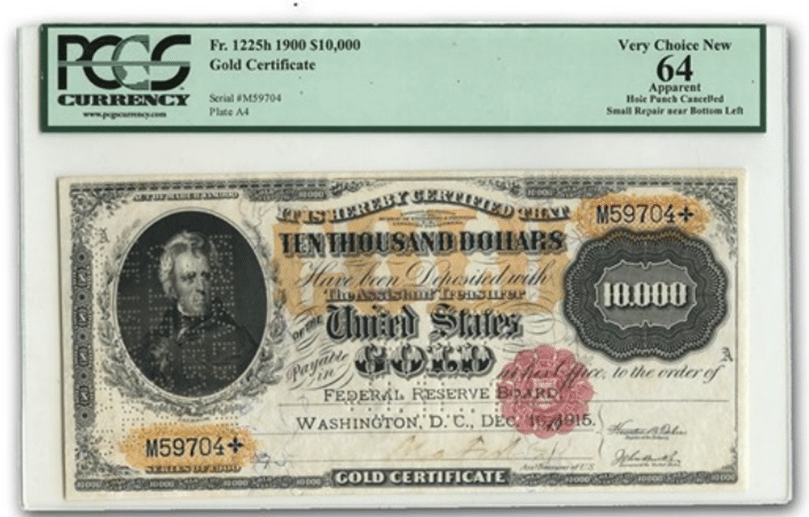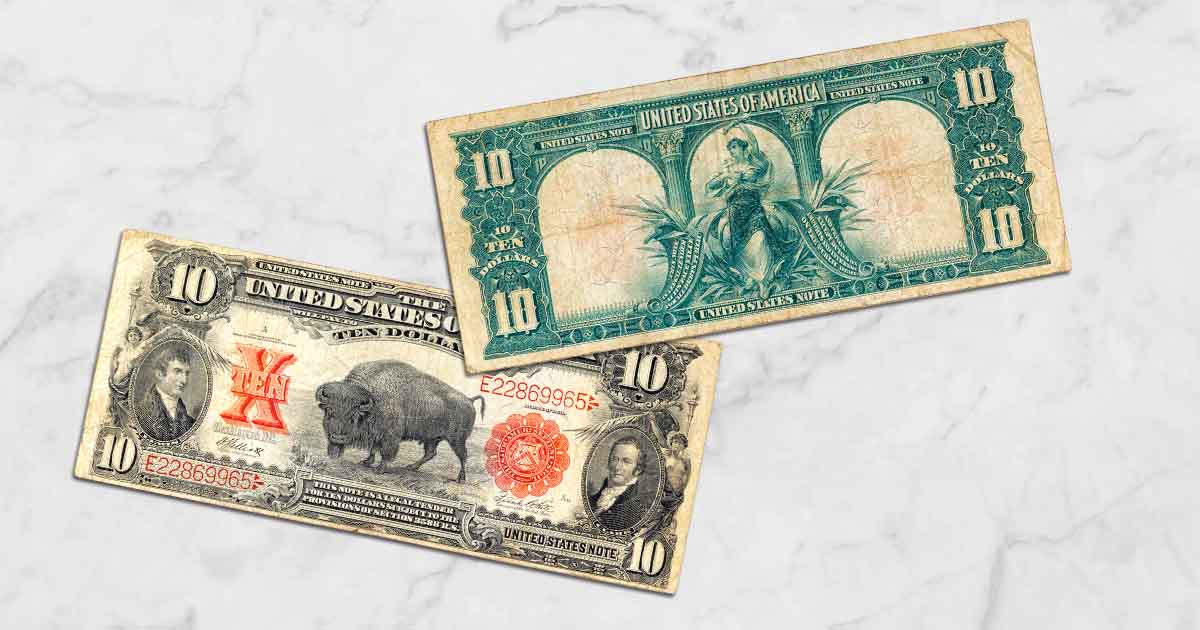
US Currency – Large Size Notes
While there were many “obsolete” notes in circulation when the Civil War began in 1861, the US and Confederate governments both realized that they didn’t have enough gold and silver coins minted in order to pay their respective soldiers and their war debts for weapons, munitions, uniforms, food, salaries, and other costs.
There are numerous types of Large Size notes.
The Demand Notes of 1861
The Federal government first printed the Demand Notes of 1861. They were printed in $5, $10, and $20 denominations with graphics on the front of the notes and ornate backs printed in green. That is how Federal government notes acquired the nickname of “Greenbacks.”
The $5 note bears an engraving of the statue of “Freedom” atop the US Capitol. The $10 note depicts a bust of President Abraham Lincoln, and the $20 note depicts an allegorical representation of “Miss Liberty” holding a sword and a shield.
These notes sparingly survived and are valuable to extremely rare. They are not frequently encountered, but the Lincoln notes are the most available of the three types.
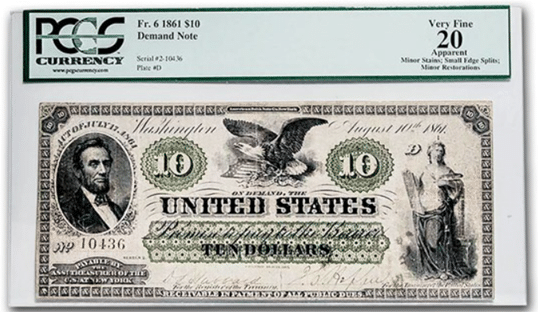
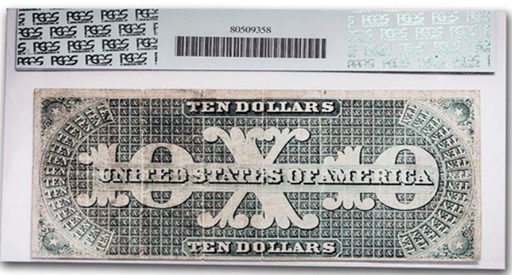
Legal Tender Issues
Legal Tender Issues are also known as “United States Notes.” They were issued to be “legal Tender for all debts, public and private.”
They were issued between 1862 and 1923. They are some of the most popular and highly-collected issues. They were issued in $1, $2, $5, $10, $20, $50, $100, $500, $1,000. $5,000 and $10,000 denominations. These were issued for such a long period, there are many affordable and collectible note types.

Compound Interest Treasury Issues
These notes are actually Legal Tender notes but for a period of three years, they earned interest at the rate of 6% a year, compounded twice during the year. These were issued in 1863 an 1864. They had denominations of $10, $20, $50, $100, $500, and $1,000 dollars.
While the notes had different fronts, the backs of the notes usually displayed the interest and redemption values for these notes for each 6 months, for the entire three year life of these notes.
The fronts of the notes had such luminaries ass Lincoln, Salmon Chase, Alexander Hamilton, George Washington, the New Ironsides ship and “Liberty and Justice.”
These are extremely scarce and valuable notes. Most collectors never see one.
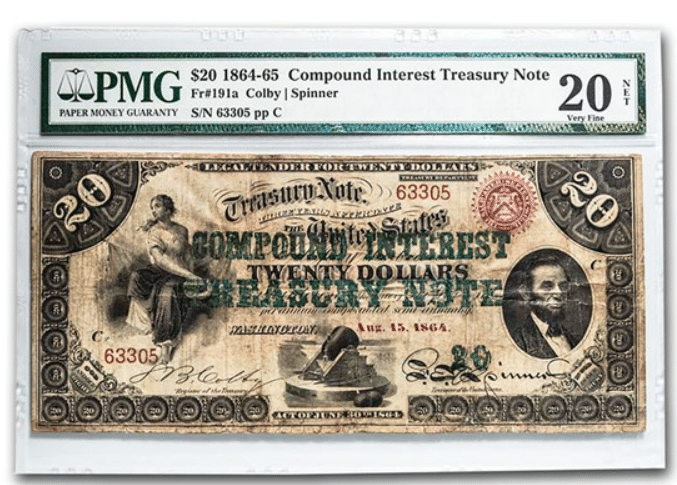
Interest Bearing Notes
These extraordinarily rare notes were issued in 1861, 1863 and 1864. There are 1 year, 2 year and 3 year notes. The 1 and 2 Year notes offered interest at 6% per year, while the 3 year note offered 7.1% interest. Most dealers have never encountered one of these, except in museums.
The 1-Year notes were issued in $10, $20, $50, $100, $500, $1,000 and $5,000 dollar denominations.
The 2-Year notes were issued in $50, $100, $500, and $1,000 dollar denominations, but the $500 and $1,000 dollar notes are listed but no examples have yet been discovered.
The 3-Year notes were issued in $50, $100, $500, $1,000, and $5,000 denominations.
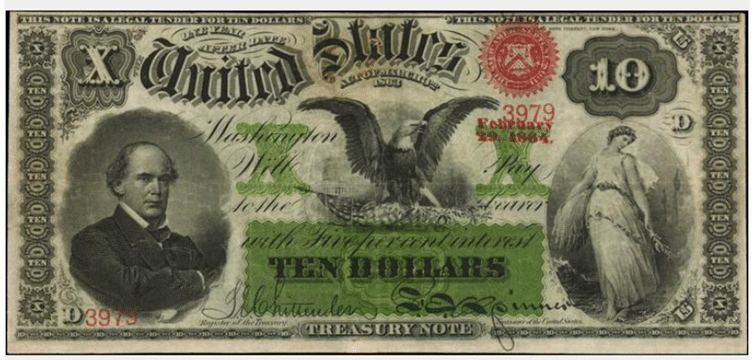
Refunding Certificates
In order to make investing in government-issued securities popular to average Americans, the Treasury department issued Refunding Certificates in $10.00 denominations. These certificates paid interest at 4% per year and that was paid at the time of issuance.
Unlike other financial instruments, these were more like bonds or stocks since the name of the purchaser was written on the front of the certificate. But those were extremely rare and only two are known to exist. Later issues were made payable to the “Bearer” so they could be easily bought, sold or traded.
These later issues scarce and seen infrequently in the marketplace.
Large Size Silver Certificates
Large Size Silver Certificates were issued from 1886 until 1923. The Series actually continued into the Small Size currency period and were dated through 1957.
These certificates were redeemable into exchange for either a Silver Dollar coin or for Silver granules at the Federal Reserve or Treasury Department. This extremely popular series contains many of the most well-known and desirable types of Large Size currency.
Silver Certificates were issued in $1, $2, $5, $10, $20, $50, $100, $500, and $1,000 denominations. Some examples are:
- 1896 Educational Notes – $1, $2, and $5
- 1899 Black Eagle Note – $1
- 1886 $5 Grant – Five Silver Dollars
- 1899 $5 Chief Note
- 1923 $5 Lincoln Porthole Note
- 1886 $10 Hendricks Tombstone Note
- 1880 $20 Stephen Decatur Note
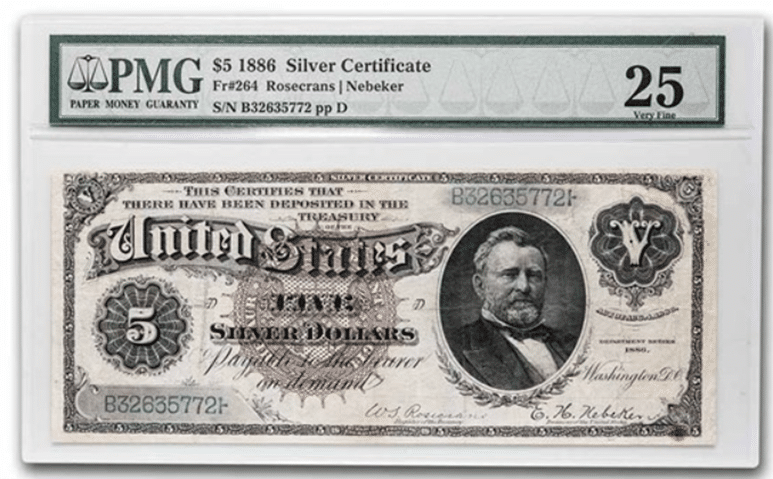
Treasury or Coin Notes
These notes were issued to offset the bullion purchases of gold and silver by the Treasury Department. These notes were issued in 1890 and another series in 1891 and in denominations of $1, $2, $5, $10, $20, $50, $100 and $1,000 denominations.
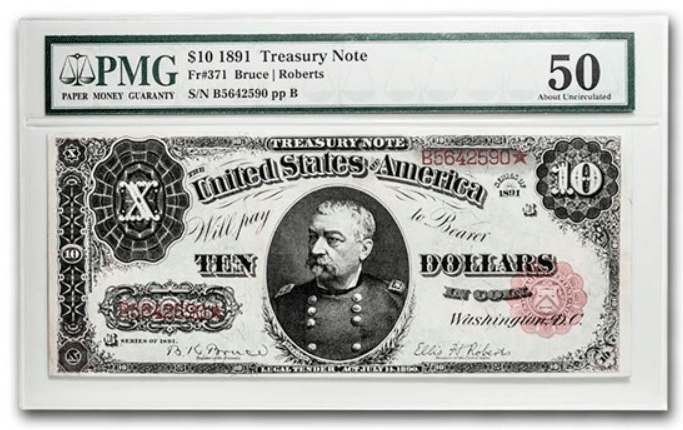
National Bank Notes
National Bank Notes were issued by the United States beginning in 1863. They were issued by different National Banks all across the country that were chartered by the United States government.
They were typically backed by US Treasury Bonds after they were deposited in the US Treasury, credited to the National Bank’s account with the Treasury Department. One stipulation to receiving that federal charter was that the National Bank had to maintain a redemption fund in order to be able to handle redemptions of these notes for coinage.
The minimum requirement was that the redemption fund must have at least 5% in gold or silver coins, of the outstanding balance of issued notes in circulation. This would provide in most instances for the bank’s solvency.
From 1863 to 1908, there were different series of large size National Bank Notes issued. The banks all shared the same engraving style, with the title of the chartered bank and the bank’s unique charter numbers differentiating them from one another.
These notes were signed by the specific bank officers, the President and Treasurer. The lowest serial numbers available or the lowest numbered sheets were often acquired by the bank of its officers.
The First Charter
The First Charter period went from 1863 to 1882. The First Charter notes had red seals and red charter numbers on each note. They were printed in $1, $2, $5, $10, $20, $50, $100, and $500 denominations.
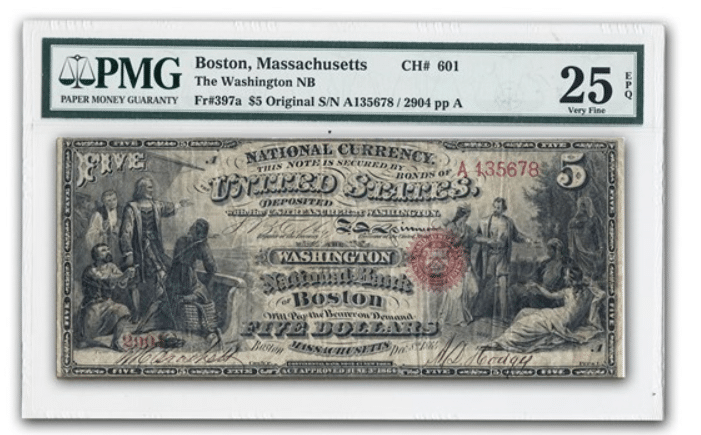
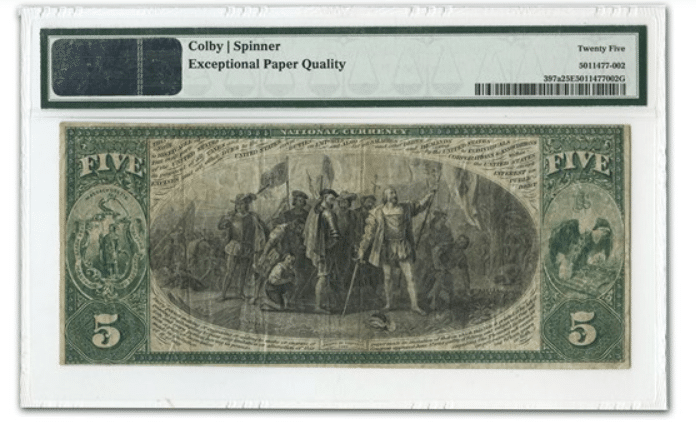
The Second Charter
The Second Charter period went from 1882 to 1902 and the Series of 1882 had Brown treasury Seals, a Brown Back, but red Charter Numbers. The Second Series of 1882 had blue Treasury Seals, and a Green back with 1882-1908 imprinted on it.
The Third Series of 1882 had a Blue Treasury Seal, a Green back but had the denomination spelled out on that Green back.
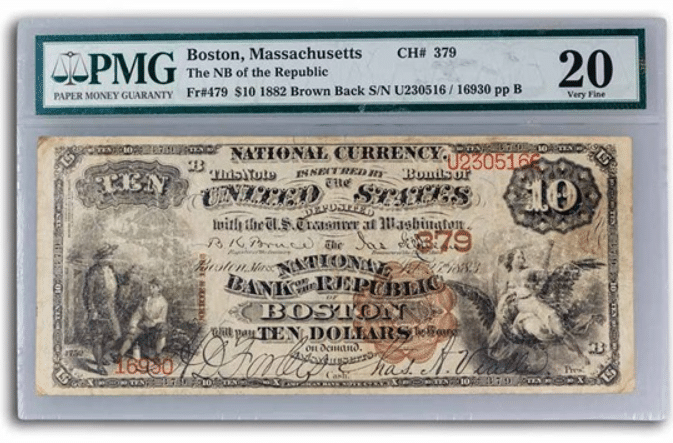
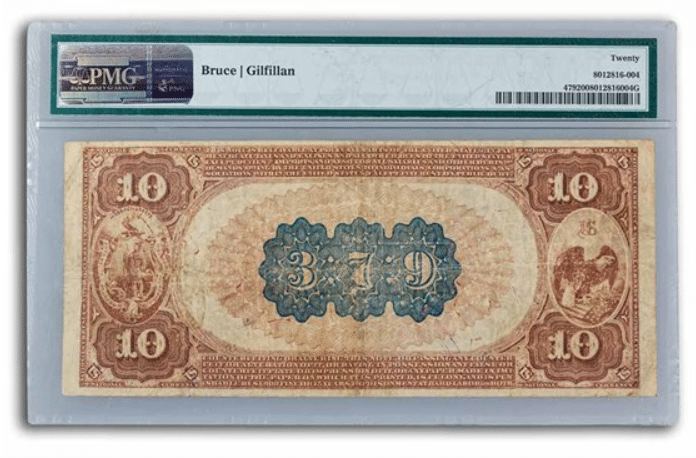
The Third Charter
The Third Charter period went from 1902 until 1922. The First Issue notes had red serial numbers and red charter numbers and had a scene depicted in green on the back. The Second Issue has the same characteristics but also had “1902 – 1908” imprinted in green on the back.
All charter periods had the typical denominations up to $100 or $500.
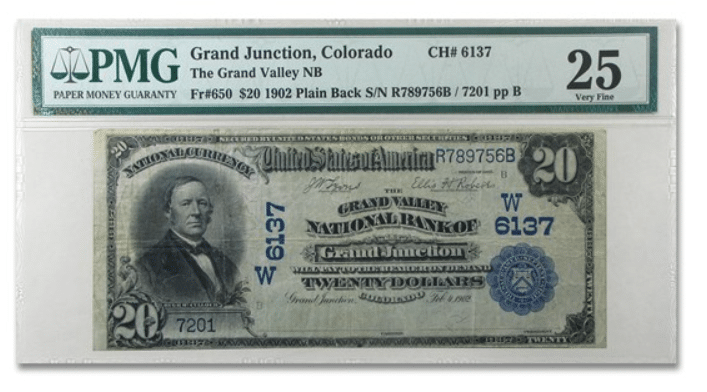
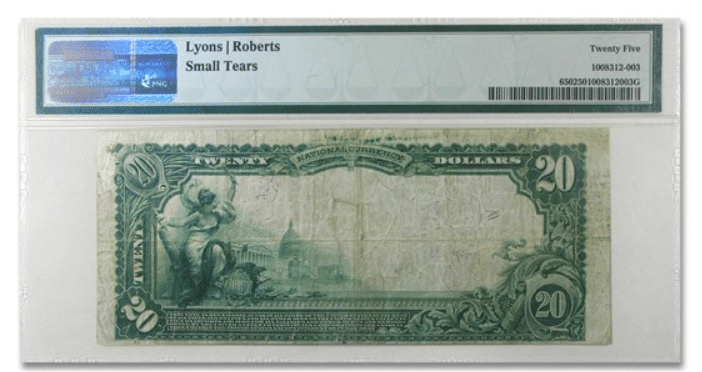
Federal Reserve Bank Notes
The Federal Reserve System was created in 1913 and bank notes were created to originally be paid through the system. Federal Reserve offices were created in 12 major cities:
- Boston
- New York
- Philadelphia
- Richmond
- Cleveland
- Atlanta
- Chicago
- St. Louis
- Minneapolis
- Kansas City
- Dallas
- San Francisco
National Currency was issued by these Federal Reserve banks in two series. The first one was limited in 1915 and a second series in 1918, in all denominations. The later notes were issued in $1, $2, $5, $10, $20, and $50 notes.
Each note has a former President grace the front of the note and a historical scene or allegorical image on the back.
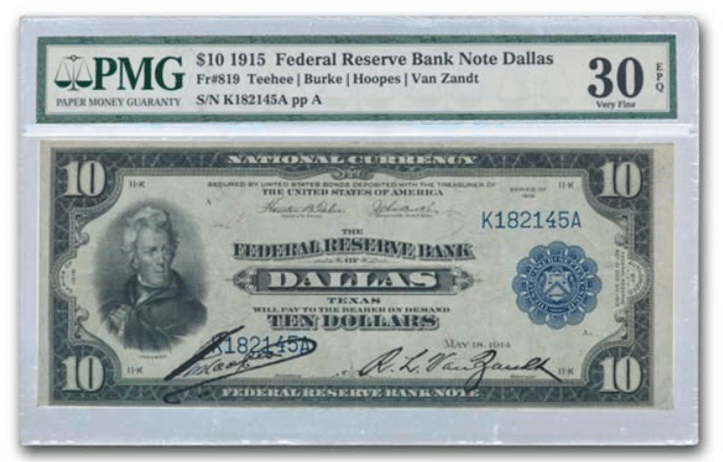
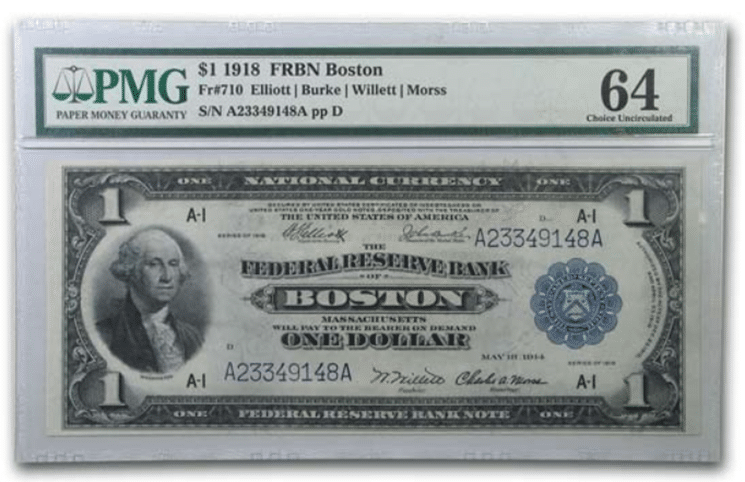
Federal Reserve Notes
These notes were issued under the aegis as the previous Federal Reserve Bank Notes. This entire series is dated 1914 and $5, $10, $20, $50, $100, $500, $1,000, and $5,000 notes were all printed.
Unlike the Federal Reserve Bank Notes (previous), these notes are NOT an obligation of the Federal Reserve Banks themselves. These notes are the obligations of the United States government itself.
However, they were distributed to member banks and to the public by each of the 12 Federal Reserve Banks. The earlier issue of these notes were printed with red US Treasury seals while the later issues had blue Treasury seals. Notes were signed by the Secretary of the Treasury as well as the Treasurer of the United States.
These notes also bear portraits of past US Presidents on the front through the $50 bill. Higher denominations depicted Benjamin franklin ($100), John Marshall ($500), Alexander Hamilton $1,000), James Madison ($5,000) and Salmon P. Chase ($10,000). The backs all depict allegorical representations of historical events or symbols. All notes had greenbacks.
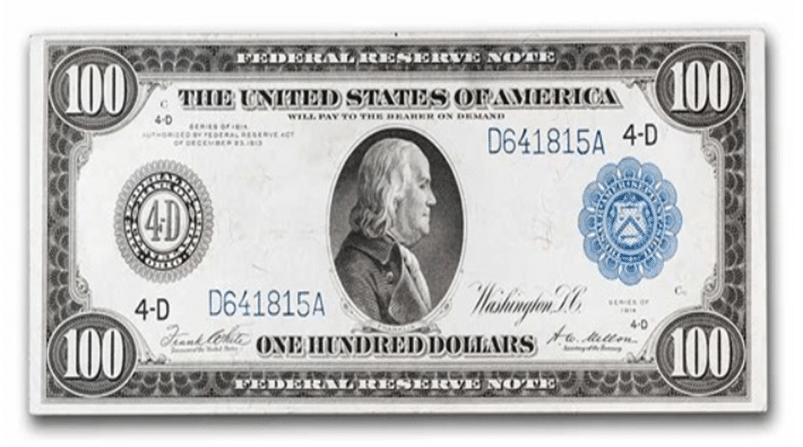
National Gold Bank Notes of California
These bank Notes are directly linked to the California Gold Rush of 1848. The coins made from California Gold Rush gold, are well-depicted on the backs of these notes. These are special National Bank Notes from various California banks.
These notes were actually printed on a gold colored paper which makes them instantly recognizable and is a strong reminder of gold.
The backs of each of these notes shows an assortment of US gold coins, from small $1.00 Gold coins to large $20.00 Gold Double Eagles.
Congress authorized 9 banks in California to be able to exchange these special gold notes for gold coins and vice versa. The banks involved were both “National Banks” and “Gold Banks.”
These notes were issued in $5, $10, $20, $50, and $100 denominations. There were supposed to also be $500 dollar notes issued as well but none are known to exist.
The beautiful and historic notes are scarce and when they are found, they’ve been well-circulated.
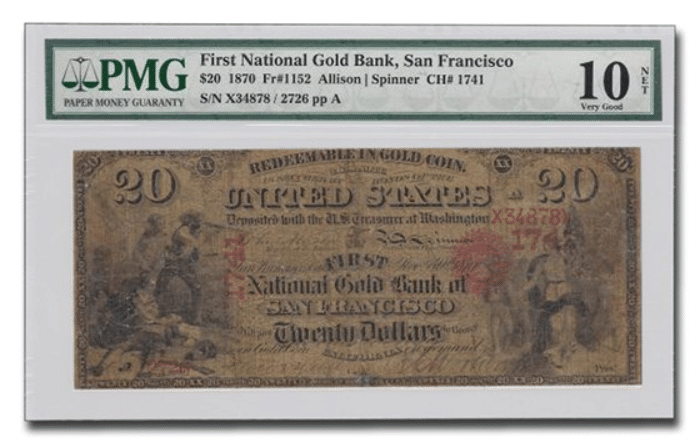
Gold Certificates
Gold Certificates are some of the most colorful and attractive notes ever printed by the United States government. Many of the nine series of Gold Certificates are printed on gold paper. But only four of these certificates were circulated to any extent.
These notes were backed by the Gold Reserves of the United States Treasury and were redeemable in gold coins. Three issues of Gold Certificates were all issued in 1863 and none of these notes are available or collectible. All of them are unknown or unique.
The issues of 1882 are the first collectible Gold Certificate notes, but they are still very expensive if you can find them. There are $20, $50, $100, $500 (Scarce) and $1,000 (Rare) notes. There were also $5,000 and $10,000 notes in the same series, but were redeemed or lost to time.
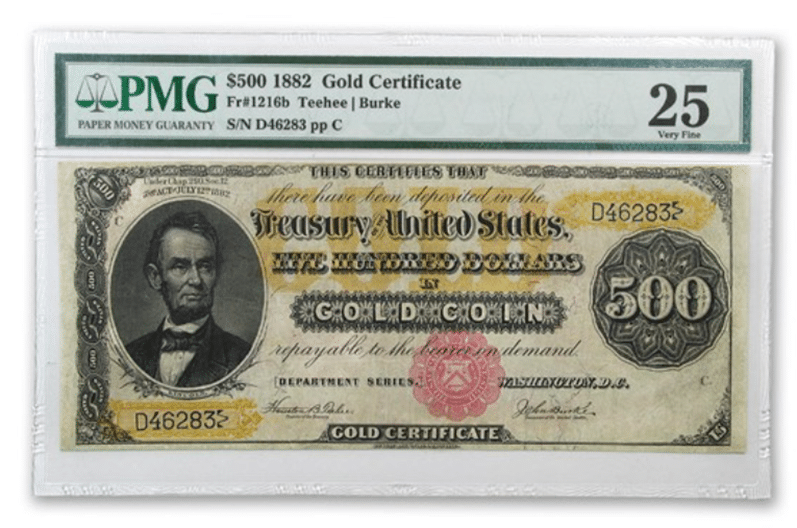
The next series is from 1905 and 1906. These $20 notes are called the famous “technicolor” notes for the colors radiating from them. They are available, beautiful, and highly collectible.
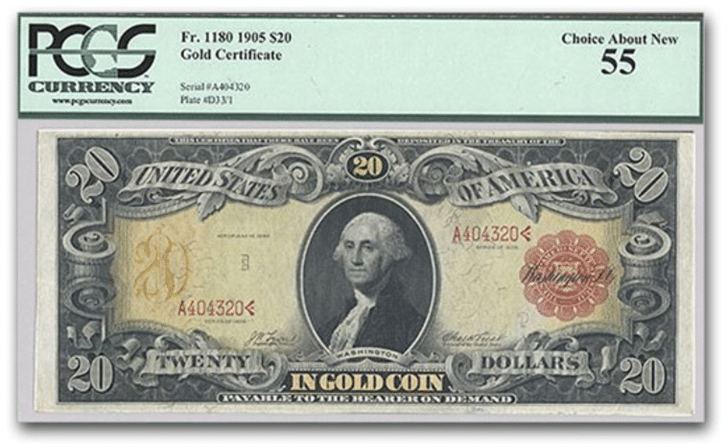
The 1907 Series contained a $10.00 Gold Certificate and a $1,000 Gold Certificate. The $10.00 has a portrait of Michael Hillegas, first Treasurer of the United States. The $1,000 depicts Alexander Hamilton and is extremely scarce.
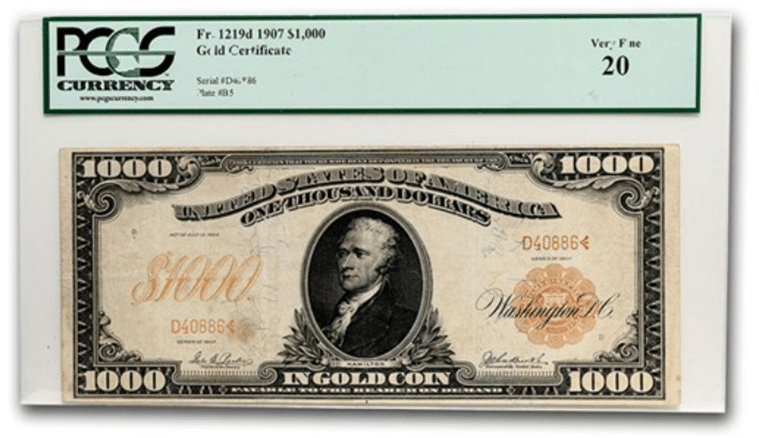
In 1922, the Gold Certificates were printed in abundance. Just 11 years later (1933) they could no longer be redeemed for gold coins, as President Roosevelt recalled those coins.
There is a popular $10.00 Certificate, a $20.00, a $50.00, a $100.00, a $500.00 and a $1,000.00 Gold Certificates.
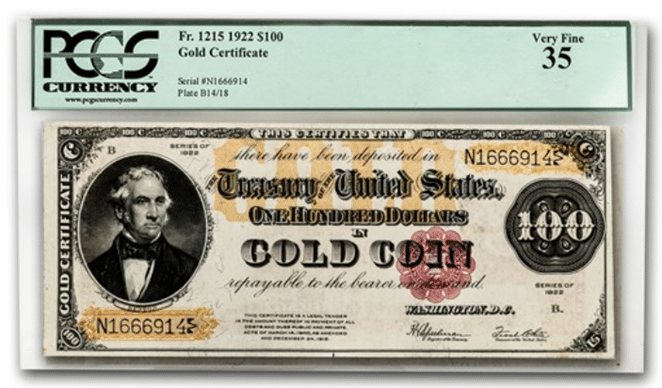
The final Large Size Gold Note was “ILLEGAL TO OWN” for many years. It is a 1900 $10,000.00 in Gold Coin Certificate. All of these were redeemed and destined to be incinerated but fate intervened.
The history of this note stems from a fire at the then “new” Washington, D.C. Post Office that occurred on December 13, 1935. During the fire, many government records were tossed out of the windows of the building and into the street below to keep them from being destroyed.
Among these records were several hundred canceled $10,000 Gold certificates. Many onlookers picked the notes up and took them home. This is the accepted explanation behind why many are found with moisture stains and a few with charring.
After being illegal to own for many years, collectors began to embrace these notes as great pieces of history in recent years. The earlier series of this note that were issued are extremely rare, and very valuable. This note is only printed on the front side.


